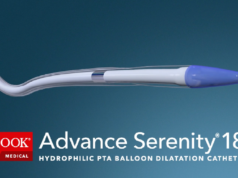
B Braun has revealed that 12-month results from the LOCOMOTIVE EXTENDED study of the company’s Multi-Loc multiple stent delivery system have been published in Vasa: European Journal of Medicine. The study authors, Klaus Amendt (Diakonissenkrankenhaus Mannheim, Mannheim, Germany) and colleagues conclude that the Multi-Loc “provides promising results concerning target lesions revascularisation and primary patency at 12 months”.
They add that use of the Multi-Loc stent system is both safe and effective for provisional repair of flow-limiting dissections or recoil following plain balloon angioplasty and drug-coated balloon angioplasty of the femoropopliteal artery.
The LOCOMOTIVE EXTENDED (Multi-Loc for flow-limiting outcomes after plain old balloon angioplasty and/or drug-coated balloon treatment in the infrainguinal position with the objective to implant multiple stent segments) study is a prospective, single-arm, multicentre observational study, in which B Braun’s Multi-Loc multiple stent delivery system was used for provisional stenting of the femoropopliteal artery.
Amendt et al enrolled 357 patients with 449 femoropopliteal lesions and a mean age of 71±10 years. The mean lesion length was 16±9.7cm; 44.5% of which were TASC II C/D lesions and 31.4% were chronic total occlusions.
At six and 12 months, the authors report that freedom from clinically-driven target lesion revascularisation was 95.5% and 88.7% and the primary patency rates were 88.7% and 82.3%, respectively.
At 12 months, significant improvements were noted in Rutherford categories and ankle-brachial indices, and in multiple regression analyses, both diabetes mellitus and no distal run-off vessel showed a trend toward worse target lesion revascularisation, while other factors such as drug-coated balloon predilection or the lesion length were not predictive.
Considering future research, Amendt and colleagues write: “Randomised controlled trials are needed to compare the focal stenting strategy to conventional interventions with long stents. Possibly, the efficacy of spot stenting could be further increased by combining it with additional preparation techniques, such as vessel scoring or debulking.”












